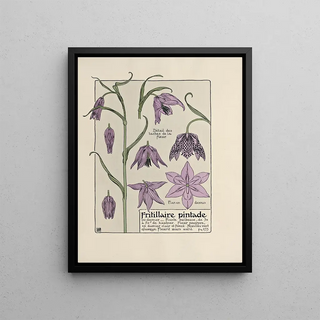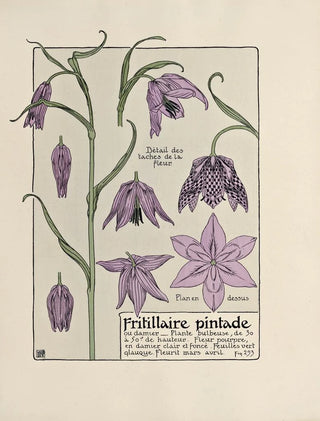Art print | Fritillary Guinea Fowl - Maurice Pillard Verneuil


View from behind

Frame (optional)
Art print Fritillaire pintade - Maurice Pillard Verneuil – Engaging introduction
In the fascinating world of decorative art, "Fritillaire pintade - Maurice Pillard Verneuil" stands out for its elegance and refinement. This piece, which depicts the delicate beauty of the fritillary guinea fowl, a plant with exotic patterns, is a true homage to nature. Immersing oneself in this composition, the viewer is transported to a universe where botany and aesthetics meet, revealing a subtle harmony between shapes and colors. The richness of this painting invites deep contemplation, where every detail seems to tell a unique story, celebrating the splendor of the plant world.
Style and uniqueness of the work
Maurice Pillard Verneuil's style is both bold and delicate, blending influences of symbolism and Art Nouveau. In "Fritillaire pintade," the artist plays with sinuous curves and floral motifs, creating a dreamlike atmosphere that enchants the eye. The vibrant hues and subtle nuances of the fritillary guinea fowl, highlighted by a harmonious background, demonstrate an exceptional mastery of color and composition. This piece stands out not only for its visual beauty but also for how it captures the very essence of nature. The stylized shapes and meticulous details reveal careful attention to each element, making this work a perfect example of the decorative art of its time.
The artist and his influence
Maurice Pillard Verneuil, an emblematic figure of Art Nouveau, knew how to leave his mark through an innovative approach to decorative art. His work, influenced by nature and floral motifs, helped redefine the aesthetic standards of his era. Verneuil collaborated with many artisans and designers, integrating his creations into diverse spaces, from interior decoration to art objects. His ability to combine functionality and aesthetics made him a pioneer in the field of design. By exploring natural themes, he paved the way for a new appreciation of the environment, encouraging the public to see beauty in the often overlooked elements of everyday life.

Matte finish

View from behind

Frame (optional)
Art print Fritillaire pintade - Maurice Pillard Verneuil – Engaging introduction
In the fascinating world of decorative art, "Fritillaire pintade - Maurice Pillard Verneuil" stands out for its elegance and refinement. This piece, which depicts the delicate beauty of the fritillary guinea fowl, a plant with exotic patterns, is a true homage to nature. Immersing oneself in this composition, the viewer is transported to a universe where botany and aesthetics meet, revealing a subtle harmony between shapes and colors. The richness of this painting invites deep contemplation, where every detail seems to tell a unique story, celebrating the splendor of the plant world.
Style and uniqueness of the work
Maurice Pillard Verneuil's style is both bold and delicate, blending influences of symbolism and Art Nouveau. In "Fritillaire pintade," the artist plays with sinuous curves and floral motifs, creating a dreamlike atmosphere that enchants the eye. The vibrant hues and subtle nuances of the fritillary guinea fowl, highlighted by a harmonious background, demonstrate an exceptional mastery of color and composition. This piece stands out not only for its visual beauty but also for how it captures the very essence of nature. The stylized shapes and meticulous details reveal careful attention to each element, making this work a perfect example of the decorative art of its time.
The artist and his influence
Maurice Pillard Verneuil, an emblematic figure of Art Nouveau, knew how to leave his mark through an innovative approach to decorative art. His work, influenced by nature and floral motifs, helped redefine the aesthetic standards of his era. Verneuil collaborated with many artisans and designers, integrating his creations into diverse spaces, from interior decoration to art objects. His ability to combine functionality and aesthetics made him a pioneer in the field of design. By exploring natural themes, he paved the way for a new appreciation of the environment, encouraging the public to see beauty in the often overlooked elements of everyday life.






